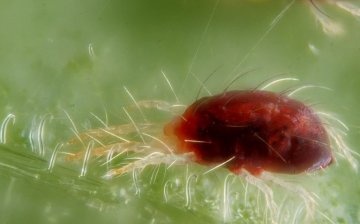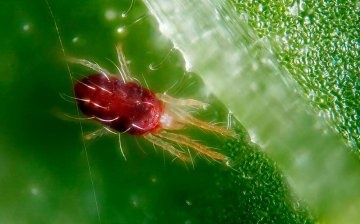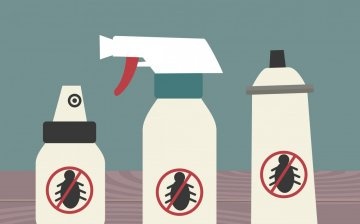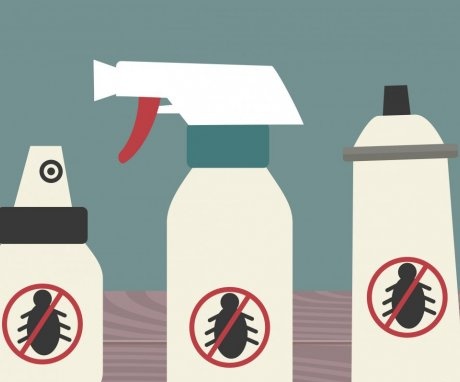What does a spider mite look like on indoor plants and how to get rid of it?
Spider mites often cause irreparable harm to indoor plants. It is difficult to see him at first, then get rid of him.
Content:
- Description of the pest
- Biological and chemical control methods
- The best folk remedies
- Prevention of infection
Description of the pest
Many species of microscopic arthropods are called spider mites. Herbivorous ticks (as opposed to those that feed on the blood of animals and humans) belong to several families of the Akariformes order of the Arachnids class. Their size, depending on the type, ranges from 0.5 to 2 mm.
Through a microscope, you can see the structure of the body. It is divided into abdomen and cephalothorax and is most often covered with fine bristles. There is a proboscis on the head for piercing tissues and sucking out juice. Body color can be:
- Milky white
- Reddish
- Orange
- Yellow-green
Ticks differ in the number of legs, there can be 2 or 4 pairs. They have microscopic claws that help ticks firmly hold onto the leaf surface. All ticks multiply rapidly. The female gradually lays 100 to 200 eggs, each of which matures up to 3 days. Almost all of them will grow a new tick in a couple of weeks, which will soon begin to multiply.
During the period of development, they go through several stages:
- Egg
- Prelarva
- Larva
- Protonymph
- Nymph
The change of each phase is accompanied by molting. All types of mites are divided into:
- Polyphages affecting a wide variety of plant species, including conifers and deciduous.
- Monophages preferring one genus of plants.
- Oligophages affecting certain species.
It is difficult to determine the name of a species that has settled on flowers without a microscope. But this is not necessary. Despite the wide variety of species, the lifestyle and harm caused by ticks are practically the same, as are the methods of dealing with them.
The tick is very small, it eats a little at a time, but they "take" in quantity.
Each tick pierces the leaf or bites into it. He begins to feed on the sap of the plant. As a result, bite marks become visible on the leaves and other parts. They are easy to spot in the light. Yellow or white spots appear on the leaves. Sometimes the leaf changes shape (curls) or color. If there are a lot of them, first individual parts dry out, and then the whole plant.
Ticks are most often found on the back of leaves. They scurry about a thin web that is difficult to see with the naked eye. With its help, ticks move from one plant to another. The cobweb is usually located between the veins of the leaf. It shows traces of their vital activity, the skins left after molting. They look like a light coating of gray or white ash. The web becomes noticeable only when the plant is very badly affected or has already disappeared. Therefore, you need to start looking for it after punctures or light spots, obtained after they merge, become noticeable on the leaves. A magnifying glass is used to search.
Biological and chemical control methods
To kill the tick, biological preparations are used:
- Akarin.
- Apollo is a class 4 drug that prevents ticks from multiplying.
- Bicol, Bitoxibacillin destroy pests.
- Fitoverm is a biological preparation that is used up to 3 times every 5 days.
Chemicals - acaricides to kill ticks or interoacaricides against ticks and aphids, quickly and effectively kill pests. But the drugs themselves are harmful to the inhabitants of the house, so their use can harm, first of all, the owners. Therefore, the processing must be carried out on the balcony or in the garden, if the temperature is above zero.
Ticks very quickly get used to chemicals, and after 2 treatments they stop responding to acaricide. The most popular chemical protection products:
- Actellik
- Demitan
- Karate
- Nissoran
Plants with smooth leaves are immersed in a bucket with a preparation with the entire crown.
The best folk remedies
There are many popular ways:
- UV treatment is effective because the mites are afraid of exposure to rays of the long (315-318 nm) or medium (280-315 nm) range. Other rays will damage not only mites, but also plants. The lamp is switched on once a week for 2 minutes. Repeat the procedure up to 4 times.
- Treatment with 96% rubbing alcohol. Wipe the leaves easily and quickly with a cotton pad moistened with alcohol. They handle the window, curtains. Spraying with alcohol is not carried out, because its drops remain on the leaves for a long time and can cause burns.
Flowers in houses have been grown for a long time, but before there were no biological and chemical agents. To combat the tick, raw materials of horseradish, tobacco, garlic, black henbane, gray alder, medicinal dandelion are used:
- The roots of garden horseradish are crushed by passing through a meat grinder. Pour in water in a ratio of 1:10, mix thoroughly. Insist 1 hour, filter. The resulting composition is sprayed with flowers.
- Garlic used for the manufacture of ordinary and concentrated infusions. Concentrated is prepared for future use, it can be stored and used for a long time by adding 60 ml to water per bucket of water. To make the product stick to the leaves, add 50 g of soap. To prepare such an infusion, 0.5 kg of garlic is crushed, 3 liters of water are added. Insist 6 days in a dark place. Strain and pour into a jar with a tight lid. If the infusion is needed for 1 time, pour 200 g of ground garlic in a bucket of water. Stir, filter, spray the plants.
- From the leaves of black henbane prepare an infusion, a decoction, a powder for pollination of plants. To prepare the powder, the leaves are washed, cut and dried in the fresh air. Then they pound into powder and treat the plants with it, applying it with a brush. To prepare the infusion, 1 kg of raw materials is infused in 10 liters of water for 12 hours. Filter, add 30 g of laundry soap. To prepare the broth, mix 3 kg of fresh leaves and 10 liters of water, boil for up to 3 hours. Allow to cool, filter, add water so that the broth becomes 10 liters again.
- Gray alder leaves are used in the form of decoctions. 1 kg of raw materials is poured into 5 liters of water, insisted for a day. Then boil for half an hour. Insist for another 12 hours. The broth is filtered and used for spraying plants. The remedy helps against ticks and aphids.
- The leaves or root of dandelion medicinal is also used to prepare a drug for ticks. Roots need 300 g, and leaves 500 g per 10 liters of water. Crushed leaves or roots are poured with warm water (up to 40 ° C), kept for 3 hours. Strain and use for treatment against ticks, aphids, scale insects.
In the fight against spider mites, you need to be flexible and resourceful, change and combine techniques, alternate spraying with acaricides and rinsing with warm water, rubbing the leaves.
Prevention of infection
Ticks appear in a home in different ways. First, they get on one of the plants, penetrating the window, door, they are brought on flowers bought in the store. Once in an apartment, ticks behave differently depending on conditions. If the air in the room is dry and warm, they begin to multiply rapidly. High humidity (from 70%) inhibits insects, they reproduce slowly.
To reduce the risk of plant damage, purchased flowers are quarantined for about a month. Allocate them one room or window sill. They are examined much more often than others using a magnifying glass. If during the quarantine the tick is not found, it can be installed closer to other flowers.
The room needs to be ventilated more often by lowering the air temperature. But ticks stop their vital activity only at temperatures below 10 ° C, and even then they do not die, but go into hibernation. Plants are sprayed, increasing the humidity of the air, and wide dishes of water are placed between the flowers. As it evaporates, it increases humidity. Special moisturizers work best.
For preventive purposes, wipe all parts of the plant with water and laundry soap.
This does not apply to flowers with pubescent leaves, which should not be wiped under any circumstances. During processing, some specimens that fall on the napkin may die. It will not be possible to destroy all the ticks; they can hide in the soil and then return. Flowers with leathery leaves can be spilled in a hot shower (45 ° C). This temperature is not dangerous for plants, but ticks die from it. It is advisable to pre-treat the leaves with green soap (leave for 5 minutes) or shampoo (wash off immediately).
More information can be found in the video:

















I'm not familiar with the spider mite by hearsay and I can say that it is quite difficult to remove it. Moreover, I usually notice its presence when it has already multiplied to its full extent. Several times it happened that most of the flowers died. She was saved only by chemicals.
I agree with you completely, AnnaAlimova! We also had such a mite and brought it out chemically. reagents. Although we had to get rid of several flowers along with the earth. They threw it out. So the chemicals help you get better at the early stage.